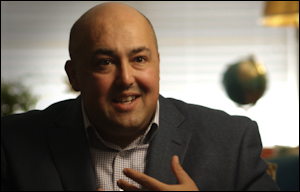
Siva Vaidhyanathan: UVa professors do a lot more work than shows up on the Internet. Photo credit: C-VILLE Weekly.
A few days ago, I delivered a rap on the knuckles to Siva Vaidhyanathan, a media studies professor at the University of Virginia. He had made what I found to be a remarkable statement in a radio interview: “The university systems throughout the state of Virginia are running lean. They’re serving students very well.” Really? Universities that had hiked tuitions 75% over the past decade were “running lean?”
In that post, I observed that UVa’s media studies department of 24 professors and lecturers was offering only 39 courses, and that lecturers had much bigger teaching loads than the professors. Moreover, I noted, Vaidhyanathan himself is not teaching a course this semester, offering the possibility that he was on sabbatical. What does that say about faculty productivity? It looked like UVa was paying big money — Vaidhyanathan $253,000 in 2014 — to spend time on research and writing instead of teaching.
Well, Vaidhyanathan saw the blog post and reached out. We had a friendly chat Monday. He credited me with asking “trenchant” questions, but said there was more to the story that what I had conveyed in my blog post. In the spirit of exploring all sides of the higher education controversy, I summarize here what he had to say.
The reason he’s not teaching any classes this semester, Vaidhyanathan said, is that he is one of twelve faculty members selected by the Dean of the College of Arts and Sciences to redesign the curricula. He has been involved full-time delving into the scholarship of teaching and in the design of new courses.
The College of Arts and Sciences requires students to take a minimum number of courses in math and natural sciences, the social sciences, history, non-Western perspectives, and humanities. Often, students take a checklist approach to areas outside their major, often gravitating to easy courses or professors and not getting much out of the experience.
A few years ago, he says, UVa professors began asking whether the process was really beneficial to students or just an exercise in catalog shopping. “We want students to understand the thought in all these areas, learn how scientists think, understand what the debates are in the humanities,” Vaidhyanathan said. “Can we restructure at least the first-year experience to give students a better tour of the modes of thought?”
Faculty members do more than teach courses, by the way. They advise students. “Even though I’m not teaching any courses this semester,” he said, I meet with two students who are writing theses. I’m meeting with a student doing independent study. We do all these extra things. Not to mention what we do with graduate students.”
Moreover, regarding the faculty-course ratios I mentioned in my blog post, he noted that four media studies faculty members are on research leave, paid by other universities to visit them. The average course load per professor is higher than my numbers indicated.
From what he has seen in academia, including teaching at two other universities, UVa places a high priority on teaching, Vaidhyanathan said. “Just last Wednesday, I sat through three of an assistant professor’s courses watching her teach and taking detailed notes. There’s a constant conversation on how to improve, how to try new technologies. There’s an ongoing debate on whether to use PowerPoint.”
When he taught at New York University, Vaidhyanathan was warned by his departmental chair not to place too much emphasis on teaching. The attitude there was that getting recognized as a good teacher before earning tenure marked a professor as someone who was giving insufficient attention to research. The attitude at UVa is different, he said. He sees scholarship and teaching buttressing one another. Staying on the cutting edge of one’s field makes one a better teacher; interacting with students gives perspective to the scholarship.
As astonishing as it may seem to some, Vaidhyanathan says he sees his job as a public service. He frequently asks himself, “Am I doing right by the taxpayers? Am I doing right by the students who are paying tuition?”
The best day of the year for him is graduation day, he says. “All the parents and students applaud us. I’ve never worked anywhere where that’s the case. They appreciate the work we do. It makes me feel really good.”
While he praises UVa, Vaidhyanathan concedes that it is a work in progress. He says that the institution had been “self-satisfied” for too long. “We’re no longer happy with just being listed in the Top Five public universities. That’s not really success.” UVa has had a shift in the conversation. “It’s not just about scoring well. Can we make a difference in childhood diabetes? Can we make a difference in big data research? Can we leverage our strengths to be one of the leaders?”
For too long, he said, UVa did not think strategically. That’s changing. “We’re hiring amazing young faculty members. We’re better connected to the needs of the Commonwealth than we’ve been in a long time.”


